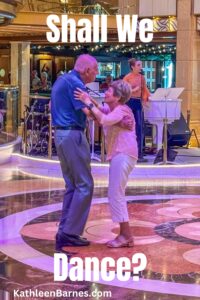 We all want lifelong brain health. There is simple memory decline that my friends and I like to call “senior moments;” then there is a condition called age-related cognitive decline and finally the serious and ultimately fatal impairments like Alzheimer’s and other forms of dementia.
We all want lifelong brain health. There is simple memory decline that my friends and I like to call “senior moments;” then there is a condition called age-related cognitive decline and finally the serious and ultimately fatal impairments like Alzheimer’s and other forms of dementia.
Knowing that Alzheimer’s runs in the female line of my family (my mother and grandmother both died of it) makes me very vigilant about my brain’s health.
And I also know that the adage, “Use it or lose it” certainly applies to the mind.
So how best to use it?
My theory is that ballroom dancing fills the bill on several fronts.
Movement
First, we know that physical exercise, especially aerobic exercise, is a primary means of preserving overall health and specifically brain health. Dancing is great physical exercise, even if the Ginger Rogers backwards-and-in-high-heels doesn’t apply to most of us anymore.
Mental stimulation
But there’s more to it than just bopping around. That’s why I specifically recommend ballroom dancing: You have to learn the steps and learn to do the dances properly. This forces some brain gymnastics and literally forges new brain pathways and the birth of new brain cells as you learn something completely new.
Socialization
We know that the people who have the most active social lives have the best memory function on old age. You can’t do ballroom dancing by yourself now, can you? That means you need a partner. You don’t have one or you don’t have a willing partner? Many ballroom dancing classes have “spares.” Who knows? Those spares might even become “permanents.”
Does this apply to you?
You’re 30-something and you don’t think this applies to you? It’s never too early to start. The healthier your brain is throughout your life, the better your cognition will be ion old age. David Snowden, a brilliant researcher from the University of Kentucky discovered this in his now-famous Nun Study. His book, Aging with Grace details the way the Sisters of Notre Dame in his decades-long study kept their brains sharp and enjoyed long and mentally clear lives.
Their biggest secrets: Keeping mentally active throughout their lives starting as teenagers. One of Snowden’s many fascinating discoveries was that the density of language the young nun’s expressed in assigned autobiographers when they entered the order was predictive of their cognitive health 60, 70 and 80 years later.
Ballroom dancing just isn’t your thing
No problem.
Join a hiking club.
Take a foreign language course at your local community college (study show you don’t even have to learn the language—you just have to try and you’ll strengthen memory pathways).
Take up sudoku.
Get a dog that needs extensive walks.
Start a bridge club.
You get the idea. The keys are to exercise, socialize and mentalize. Any combination is good.
Now I just have to convince my DH to take that ballroom dancing class with me . . .








Thanks for all your kind words!